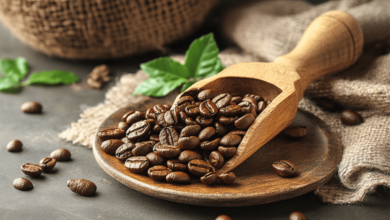Slack Rain and Frost Threats in Brazil Push Coffee Prices Sharply Higher
September arabica coffee (KCU25) Monday closed up +11.50 (+3.65%), and July ICE robusta coffee (RMN25) closed up +99 (+2.55%).
Coffee prices recovered from early losses Monday and rallied sharply. Short covering emerged in coffee futures Monday due to below-normal rainfall in Brazil, following a report by Somar Meteorologia that Brazil’s largest arabica coffee-growing area, Minas Gerais, received no rain during the week ended June 21.
Gains in coffee prices accelerated Monday due to the risk of frost in Brazil. Meteorologist Rural Clima said that below-normal temperatures and threats of frost are possible in Brazil over the next 72 hours, which could affect the coffee-growing regions of São Paulo and Minas Gerais.
Coffee prices have been under pressure over the past seven weeks, with arabica coffee falling to a 5-1/4 month low last Wednesday and robusta sliding to a 13-month low today due to concerns about higher coffee production and ample supplies.
Brazil’s ongoing coffee harvest is weighing on prices as Safras & Mercado recently reported that Brazil’s 2025/26 coffee harvest was 35% complete as of June 11, slightly behind last year’s comparable level of 37% but in line with the 5-year average of 35%. The breakdown showed that 49% of the robusta harvest and 26% of the arabica harvest were complete as of June 11. Brazil’s arabica harvest has been slowed by heavy rain in some areas.
Meanwhile, Brazil’s Cooxupe coffee co-op announced last Wednesday that its members reported the coffee harvest was 17.8% complete as of June 13. Cooxupe is Brazil’s largest coffee cooperative and Brazil’s largest exporter of coffee.
On May 19, the USDA’s Foreign Agricultural Service (FAS) forecast that Brazil’s 2025/26 coffee production will increase by 0.5% year-over-year (y/y) to 65 million bags and that Vietnam’s 2025/26 coffee output will rise by 6.9% y/y to 31 million bags. Brazil is the world’s largest producer of arabica coffee, and Vietnam is the world’s largest producer of robusta coffee.
Robusta coffee prices have underlying support as ICE-monitored robusta coffee inventories fell to a 1-month low Monday of 5,137 lots. In a bearish factor for arabica prices, however, ICE-monitored arabica coffee inventories rose to a 4-1/2 month high of 892,468 bags on May 27 and were modestly below that high at 865,898 bags as of Monday.
Smaller coffee exports from Brazil are bullish for prices. Last Wednesday, Cecafe reported that Brazil’s May green coffee exports fell by -36% y/y to 2.8 million bags.
Due to drought, Vietnam’s coffee production in the 2023/24 crop year decreased by 20% to 1.472 MMT, the smallest crop in four years. Also, Vietnam’s General Statistics Office reported that 2024 Vietnam coffee exports fell -17.1% y/y to 1.35 MMT. Last Tuesday, Vietnam’s National Statistics Office reported that Vietnam’s 2025 Vietnam’s Jan-May coffee exports are down -1.8% y/y to 813,000 MT. In addition, the Vietnam Coffee and Cocoa Association on March 12 cut its 2024/25 Vietnam coffee production estimate to 26.5 million bags from a December estimate of 28 million bags. Conversely, the USDA’s FAS on May 19 projected that Vietnam’s 2025/26 robusta coffee crop would climb +7% y/y to a 4-year high of 30 million bags.
The USDA’s biannual report on December 18 was mixed for coffee prices. The USDA’s Foreign Agriculture Service (FAS) projected that world coffee production in 2024/25 will increase +4.0% y/y to 174.855 million bags, with a +1.5% increase in arabica production to 97.845 million bags and a +7.5% increase in robusta production to 77.01 million bags. The USDA’s FAS forecasts that 2024/25 ending stocks will fall by -6.6% to a 25-year low of 20.867 million bags from 22.347 million bags in 2023/24.
For the 2025/26 marketing year, Volcafe projects a global 2025/26 arabica coffee deficit of -8.5 million bags, wider than the -5.5 million bag deficit for 2024/25 and the fifth consecutive year of deficits.







